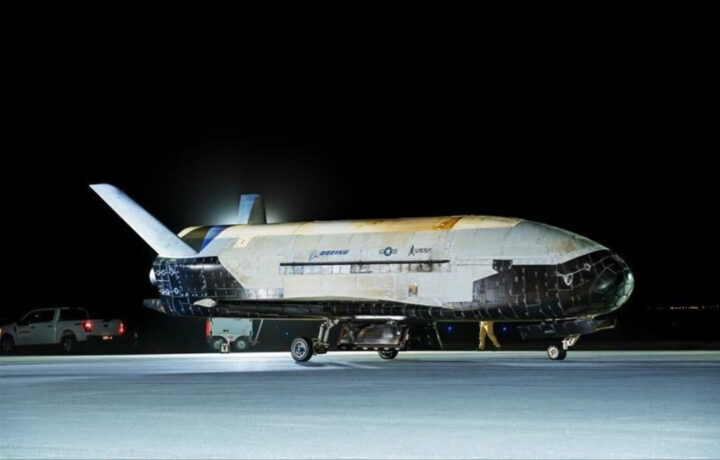The Boeing X-37B space plane will be returning to orbit in the coming weeks, the United States Space Force announced. The eighth flight of the unmanned spacecraft, officially designated Orbital Test Vehicle-8 (OTV-8), is currently scheduled to launch on August 21, 2025. Still, that date could be delayed due to weather and other unforeseen factors.
OTV-8 will launch on a Space Falcon 9, designated USSF-36, carrying a “wide range of test and experimentation objectives,” which, according to the U.S. Space Force, will include “next-generation technologies, including laser communications and the highest performing quantum inertial sensor ever tested in space.”
This latest mission is being carried out by the Space Force, in a partnership with the Air Force Research Lab (AFRL) and the Defense Innovation Unit (DIU).
The X-37B is a small, unmanned OTV that resembles NASA’s Space Shuttle but is only a fraction of its size.
Communication Tests – Laser Focused
Mission details involving the X-37B have been generally classified, but the Space Force has increased in releasing information in advance about the experiments and tests that will be carried out. In the case of OTV-8, the service has indicated it will involve the aforementioned laser communications, which are seen as integral to the future of space communications.
“Mission 8 will contribute to improving the resilience, efficiency and security of U.S. space based communications architectures by conducting laser communications demonstrations involving proliferated commercial satellite networks in Low Earth Orbit,” the space service added.
Lasers can produce infrared light with a shorter wavelength, and that can offer a significant advantage in communication systems, notably enabling greater data transmission capacity. Shorter wavelengths allow for more data to be packed into each transmission.
Moreover, laser communication can be more secure than traditional radio frequency transmissions, in part due to the targeted nature of laser beams.
“The use of proliferated relay networks enhances the resilience of U.S. space architectures by ensuring that they contain no single point of failure,” the Space Force explained.
The Space Force noted that the upcoming experiments come as part of a broader push in its efforts to “uphold the safety and security of the space domain.” That has included enhancing the resilience and flexibility of U.S. orbital systems.
“OTV-8’s laser communications demonstration will mark an important step in the U.S. Space Force’s ability to leverage proliferated space networks as part of a diversified and redundant space architectures,” said Chief of Space Operations Gen. Chance Saltzman. “In so doing, it will strengthen the resilience, reliability, adaptability, and data transport speeds of our satellite communications architecture.”
Making a Quantum Leap
The other announced tests during OTV-8’s mission will be a demonstration of what is being described as the “world’s highest performing quantum inertial sensor ever used in space.”
Space Force has called for the demonstration to help inform accurate unaided navigation in space by detecting rotation and acceleration of atoms without reliance on satellite networks like traditional GPS. The technology shows promise for navigation in GPS-denied environments and consequently will enhance the navigational resilience of U.S. spacecraft in the face of current and emerging threats.
“As quantum inertial sensors would be useful for navigation in cislunar space, they additionally promise to push the technological frontiers of long-distance space travel and exploration,” the service added.
“OTV 8’s quantum inertial sensor demonstration is a welcome step forward for operational resilience in space. Whether navigating beyond Earth-based orbits in cislunar space or operating in GPS-denied environments, quantum inertial sensing allows for robust navigation capabilities when GPS navigation is not possible,” explained Col. Ramsey Horn, Space Delta 9 commander.
“Ultimately, this technology contributes significantly to our thrust within the Fifth Space Operations Squadron and across the Space Force, guaranteeing movement and maneuverability even in GPS-denied environments,” Horn.
U.S. Space Force Delta 9’s Fifth Space Operations Squadron carries out the day-to-day on-orbit operations of the X-37B in partnership with the Air Force Rapid Capabilities Office.
Mission 8 – How Long?
Since its inaugural launch in April 2010, the X-37B has spent more than 4,200 days in space. Each mission had been longer than the previous one, until OTV-7, which was in orbit for 434 days, less than half the length of OTV-6, which spent a record 908 days in space.
While not nearly as long, the Space Force acknowledged that OTV-7 saw “the first launch on a SpaceX Falcon Heavy Rocket to a Highly Elliptical Orbit,” during which time it carried out a range of test and experimentation objectives. That included a demonstration of its maneuver capability.


